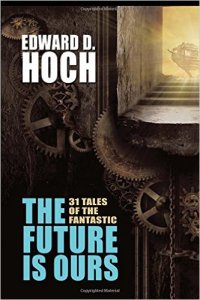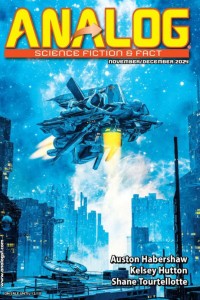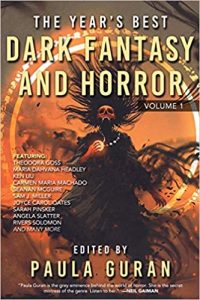Paul Di Filippo reviews Edward D. Hoch
The Future Is Ours: The Collected Science Fiction of Edward D. Hoch, edited by Steve Steinbock (Wildside 978-1-4794-0730-9, $14.99, 238pp, trade paperback), December 2015
 It seems to me that in the past, there was more permeability between the genres of science fiction and crime/mystery, more encouragement for an author to switch hats back and forth. Fulltime professional writers, eager to place a story wherever they could, had to be able to produce good, canonically recognizable fiction in either genre—if they were inclined to maximize their sales, that is. Of course, many a writer in either genre—the vast majority, in fact—proved happy to stick to just the one form they favored.
It seems to me that in the past, there was more permeability between the genres of science fiction and crime/mystery, more encouragement for an author to switch hats back and forth. Fulltime professional writers, eager to place a story wherever they could, had to be able to produce good, canonically recognizable fiction in either genre—if they were inclined to maximize their sales, that is. Of course, many a writer in either genre—the vast majority, in fact—proved happy to stick to just the one form they favored.
But eminent figures like Donald Westlake, John D. MacDonald, Robert Silverberg, Barry Malzberg, Harlan Ellison, Edward Wellen, Avram Davidson, Robert Bloch, Henry Kuttner, Isaac Asimov, Jack Vance, Lloyd Biggle, Wilson Tucker, and others proved themselves equally at home in the pages of F&SF or Ellery Queen.
Nowadays, we have lots of slipstream or postmodernist fiction that hybridizes the two genres. But authors currently working both sides of the aisle in pure form? I’m blanking on many exemplars. Kris Rusch and Dean Wesley Smith do both. Barbara Hambly and Sarah Smith. Warren Ellis. Michael Bishop and I collaborated on two straight-ahead mystery novels. Who else?
No, for whatever reasons—market-driven, career-driven, culture-driven—it seems that this is a day and age when writers do not care much to jump back and forth over the fences of their primary genre.
One fellow of the Silver Age who showed no such reluctance was Edward D. Hoch (1930-2008). Primarily and correctly labeled a mystery writer, the prolific Hoch (nearly 1000 stories to his credit) also delved exuberantly into fantastika. And now, thanks to the efforts of an editor, an heir and a fan—and publisher Wildside Press—we get twenty-nine of his out-of-this-world tales neatly assembled in a single volume.
Below is just my transect of the good stuff herein, noting that every story in the volume is entertaining and capably handled. Given that the tales are arranged in four sections, we will look at a couple of stories from each division.
First up, however, is an informative and perceptive introduction from editor Steve Steinbock, who also provides a useful contextual squib for each story.
The initial subset’s rubric is “Strange Futures,” and we begin to get a sense of Hoch’s style—at one point, Steinbock labels it “unpretentious sophistication”— and sense of high craftsmanship. When so many SF/F/H stories today seem to be overlong mood pieces without much of a hook or gimmick or driving conflict, Hoch’s stories are old-school compressed narratives with clearly defined settings, motivations, McGuffins and plots. This does not mean, however, that they lack atmosphere or emotional resonance or intellectual foundations.
A devout Catholic like Walter Miller, Hoch produces in “The Wolfram Hunters” a post-collapse tale that echoes the mordant gravitas of A Canticle for Leibowitz. A lone priest manages to counter some of the brutality of the fallen tribe, and put his parish back on a path toward a kinder world.
“God of the Playback” harks to the Galaxy-style tale wherein one player in society has come to dominate the culture. In this case, Automated Prayers Ltd has swamped the world with a canned religiosity. There’s a hint of both Fritz Leiber and Philip K. Dick in Hoch’s depiction of the smarmy, self-righteous profit-making.
Our next array of stories is grouped under “Future Crimes,” and it’s here that Hoch gets to blend his two métiers most scintillatingly. The first aspect to mention is the author’s prescience about the role that computers would play in the days ahead of the relatively primitive digital era when these stories appeared. Written in 1969, “Computer Cops” introduces the cyber-investigators Jazine & Crader, who in this debut outing have to figure out how a dedicated computer terminal under strict security is being illicitly tapped into. This clever yet generally forgotten tale deserves to be cited in every article on the forerunners of cyberpunk.
“The Forbidden Word” might be my favorite story in the book. Equally prescient with “Computer Cops,” but along a different vector, it depicts with forceful economy a world where certain terms have become politically incorrect shibboleths which, being uttered, bring jail time and obloquy. Any resemblance to our 2016 is strictly sad and ironic.
Next up are the selections deemed to be “Tales of the Dark.” Here we see Hoch’s flair for pure shivers.
“In the Straw” is an unjustly neglected piece of cosmic horror, purely Lovecraftian without being part of any Mythos. The evocation of an isolated farmstead; the characterization of worried husband and obsessed wife; the nebulous, perverse nature and origin of the inexplicably malign monster–all these facets combine to produce some true shudders.
Hoch’s chameleon-like facility with first-person point-of-view is highlighted in “Bigfish.” A man recounts the easy, semi-isolated retirement life he and his wife enjoy. One day they decide to make an outing to a local tourist attraction. What ensues seems at first a mere happenstance, but is flipped at the end to reveal the gruesome truth.
In the portion of the book dubbed “History Retold,” the focus is on the counterfactual, or historically anomalous. If you yearn to know why the Aztecs really removed hearts from people (“The Maiden’s Sacrifice”) or how a certain famous vampire fared among the Nazis (“Dracula 1944”), you will find satisfying answers here.
When I reviewed Harry Harrison’s career-capstone collection, 50 in 50, I noted that Harrison’s stories so embodied a certain zeitgeist and storytelling modality that they almost appeared to be from a country foreign to the one we and our contemporary stories and writers inhabit today. This volume of Hoch’s tales has a similar affect. They reflect different concerns and visions and strategies that might seem at times a tad old-fashioned. But as exemplary illustrations of the eternal values of the human heart, mind and soul, they also shine through. “But he went on, to the place where the water vanished into the rock. He held his breath and groped for the little flashlight in his pocket. Then he ducked his head and followed the water into the black. It was steamy here, steamy and hot with the sweat of the earth.” (“The Faceless Thing.”)
Any Jungian-potent passage like that can never go out of style.





In his review, Paul mentions 29 stories from Hoch in the collection, however, the cover of the book touts 31 stories–which is it, please?